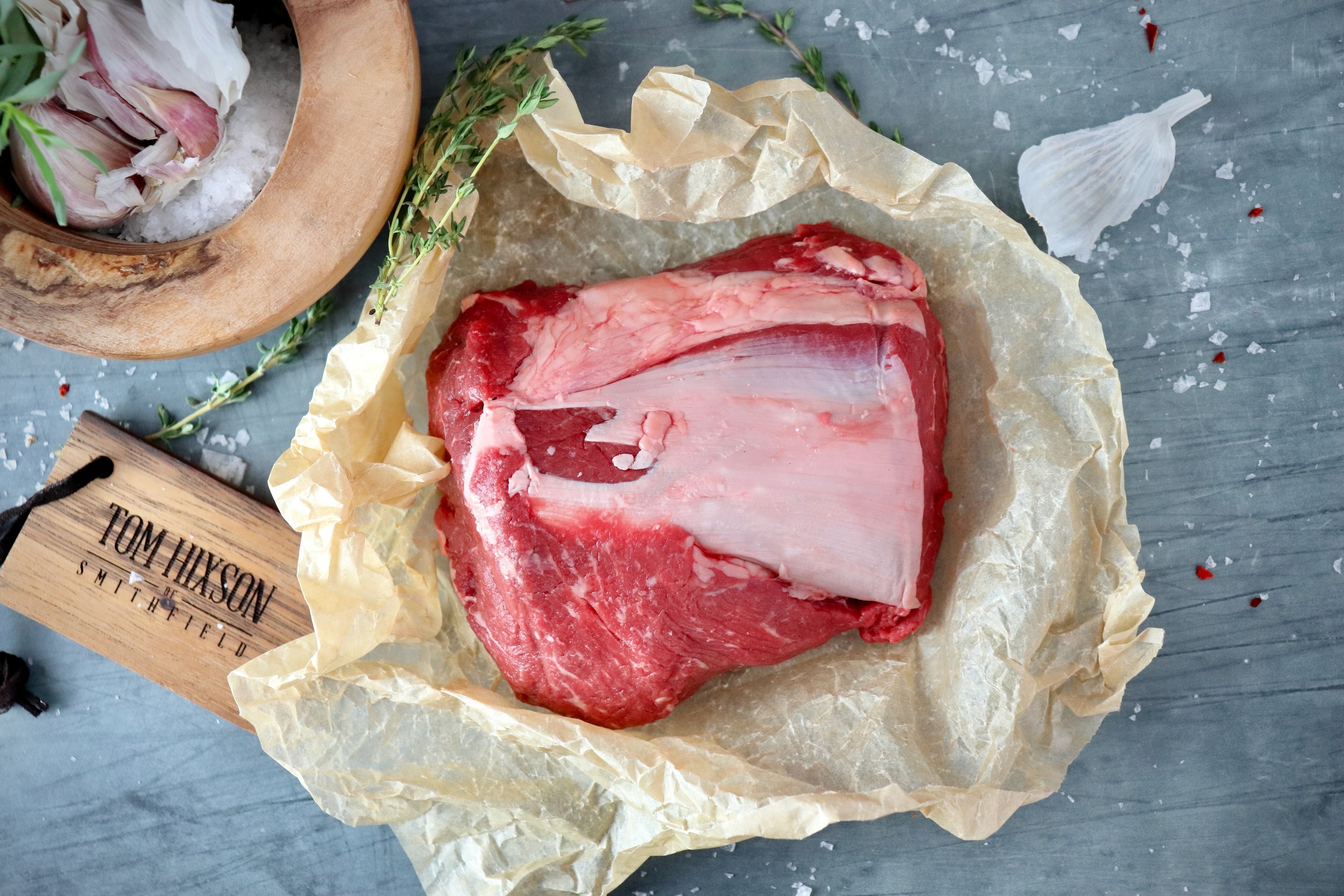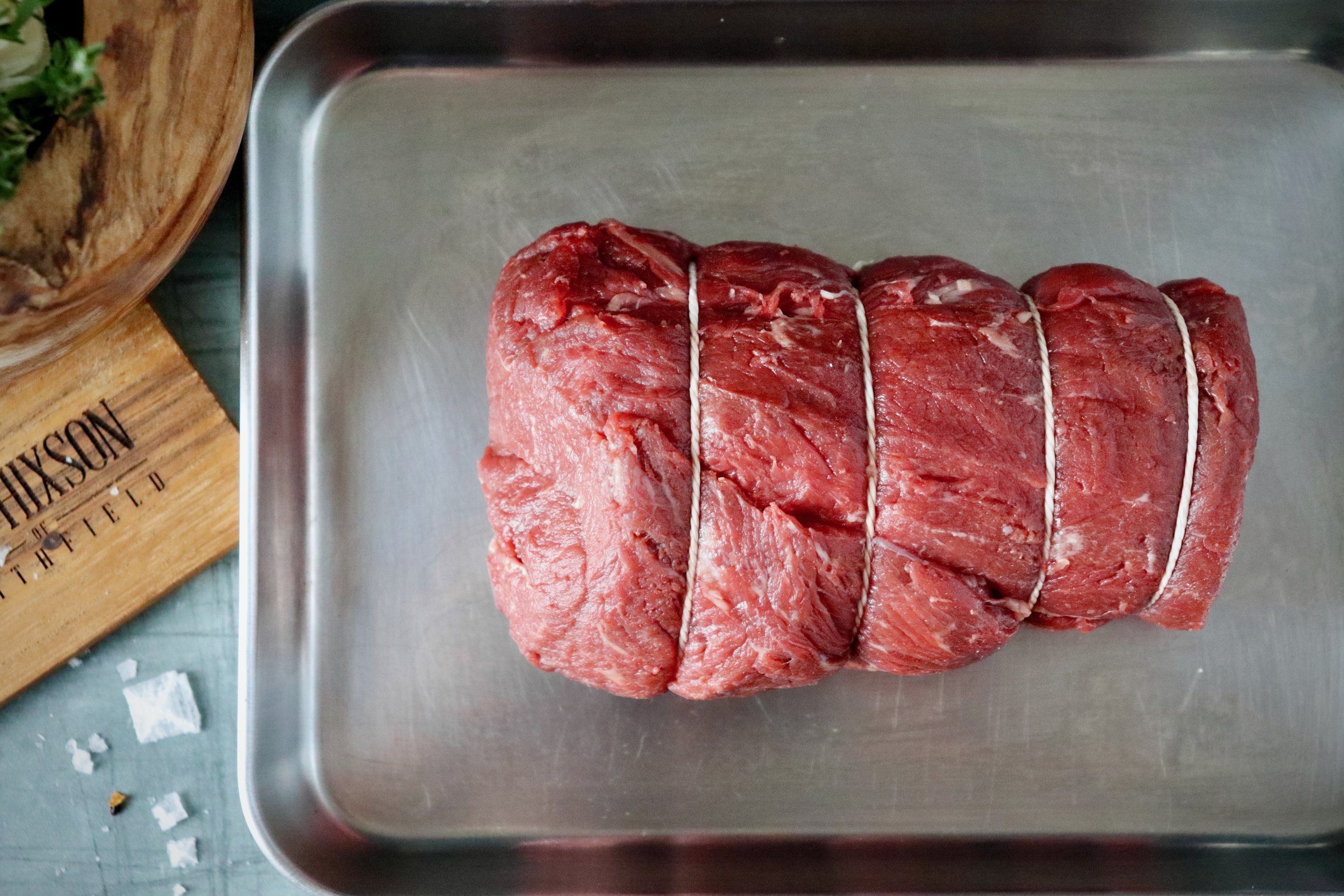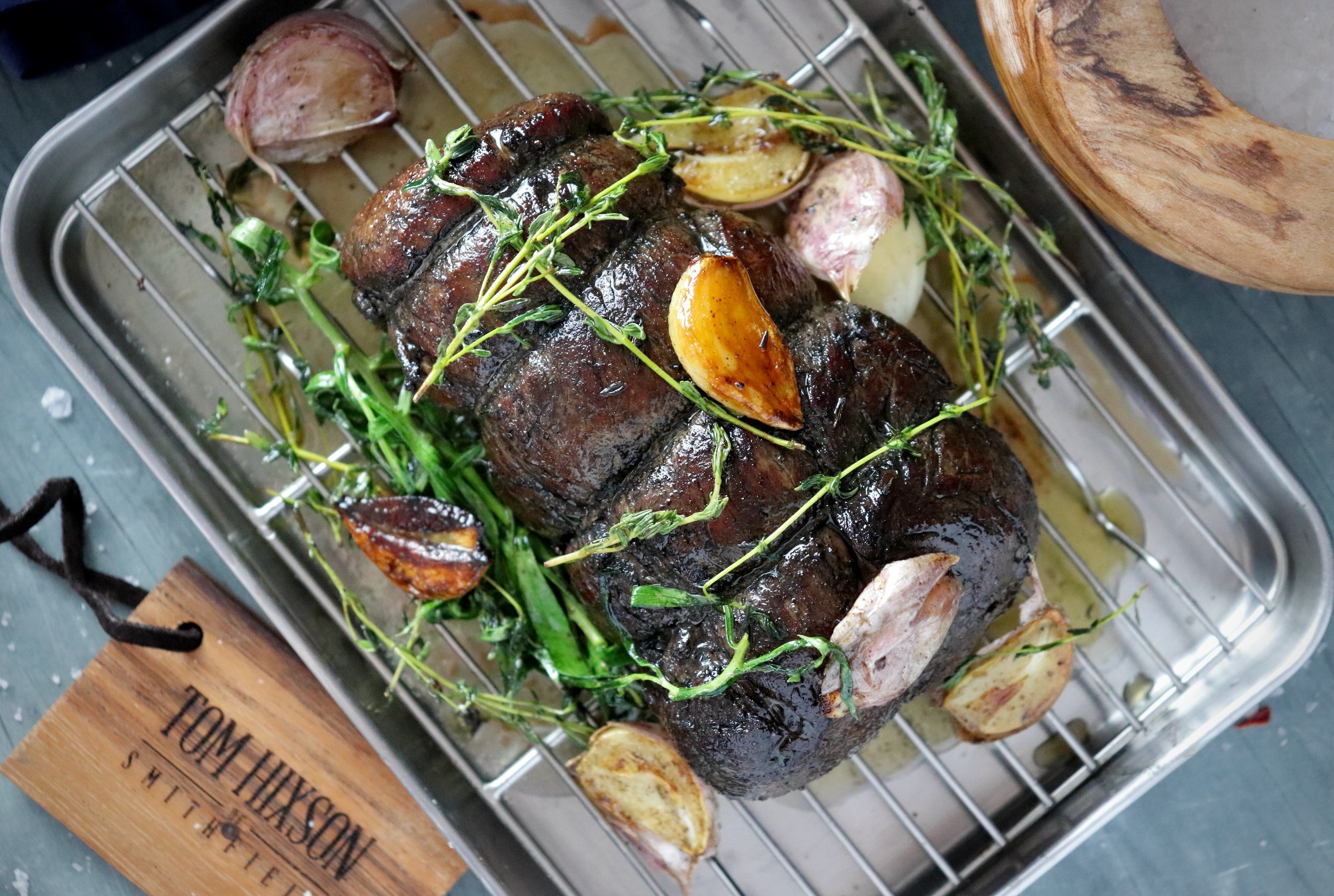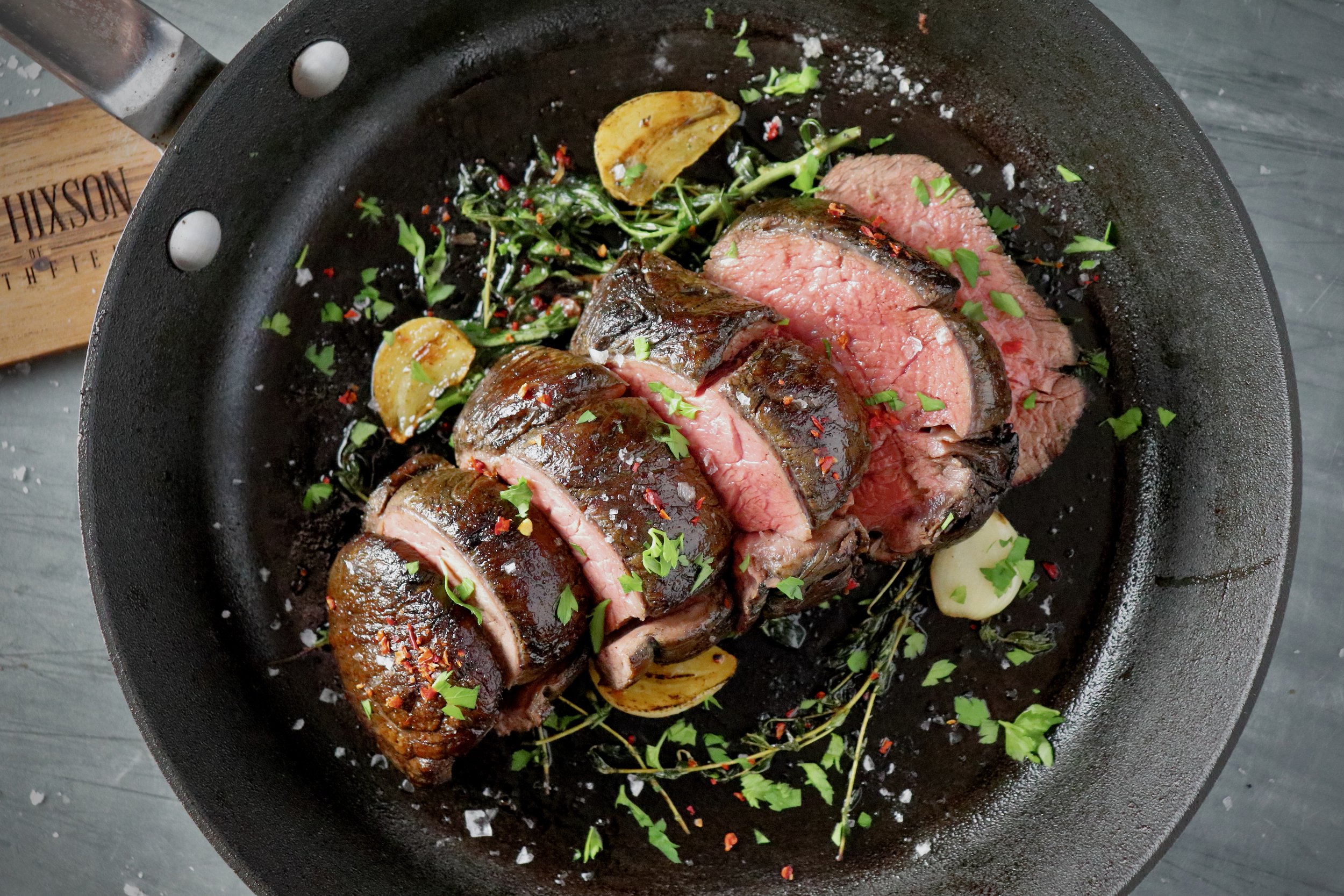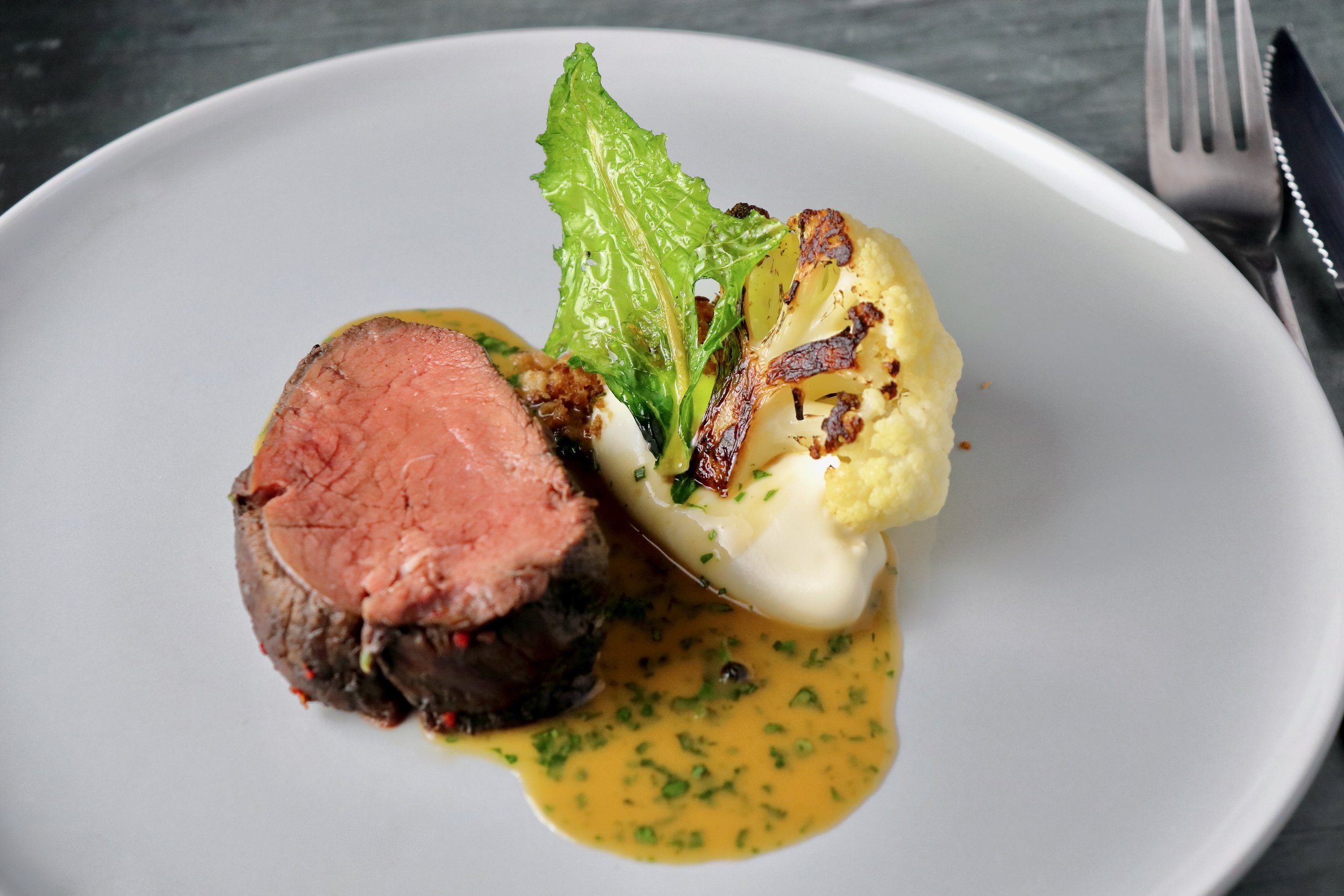Chateaubriand
Decadent chateaubriand with classic Château sauce, bone marrow and caper crumb, and cauliflower 3 ways
Originally chateaubriand was a dish named for the19th-century French aristocrat François-René de Chateaubriand, whose chef is said to have invented it. Nowadays, we know it as the highly-prized cut of beef taken from the softest part of the fillet. Luxurious, tender and succulent, and typically big enough for at least two people to enjoy, chateaubriand is more an event than a meal. Best enjoyed medium-rare for a buttery texture and delicate flavour, chateaubriand remains a true aristocrat of French cuisine and is served here with classic Château sauce prepared using white wine, veal stock and lemon parsley butter. And if that’s not decadent enough there’s creamy, silky cauliflower purée, crunchy bone marrow and caper crumb, nutty pan-roasted cauliflower and crispy cauliflower leaf.
Ingredients
Feeds 2
Black Label Argentinian chateaubriand, weighing approx. 500g
75g unsalted butter, cut into cubes
20g beef fat or olive oil
Fresh rosemary and thyme
5 garlic cloves
MAÎTRE D’HÔTEL BUTTER
150g unsalted butter, softened
20g parsley, finely chopped
0.5 lemon, juiced
Cayenne pepper
Salt
Black pepper, freshly ground
BONE MARROW CRUMB
50g unsalted butter
100g bone marrow
200g onion, very finely diced
200g panko breadcrumbs
25g chives, finely sliced
CHÂTEAU SAUCE
30g shallots, finely sliced
1 sprig thyme
30g mushroom trimmings
120ml dry white wine
250ml veal stock; I use Veal jus from TRUEfoods
100 g maître d’hotel butter, cubed and cold
Chopped tarragon
CAULIFLOWER PURÉE
200g cauliflower, finely chopped
150g whole milk
100g double cream
3g salt
CHARRED CAULIFLOWER
0.5 cauliflower
20ml olive oil
CRISPY CAULIFLOWER LEAF
Cauliflower leaves
Olive oil
Salt
Method
Prepare the chateaubriand the night before along with the maître d’hôtel butter. Remove the silverskin from the chateaubriand. Tie but don’t pull the string too tight; fillet is very soft meat. Put the chateaubriand in the fridge overnight, uncovered.
Argentinian chateaubriand
Chateaubriand, trimmed and tied
MAÎTRE D’HÔTEL BUTTER
1. Put the softened butter in a bowl.
2. Add the lemon juice and beat with a maryse or wooden spoon until fully incorporated. This is easier with a machine fitted with a flex edge beater.
3. Work in the chopped parsley.
4. Season to taste with cayenne, salt and pepper.
5. Roll the butter in cling film to form a sausage. Refrigerate.
BONE MARROW CRUMB
1. Place a pan over a medium heat and add the butter and bone marrow. When it’s foaming, add the onions and capers and cook gently until soft and golden.
2. Pass through a sieve and return the strained fat to the pan. Reserve the onions and capers.
3. Place the pan back over a medium heat and add the breadcrumbs. Fry until golden. Strain again.
4. Mix the breadcrumbs with the onions and capers. Season to taste.
5. Spread out over kitchen paper on a baking tray. Leave to dry out in a low oven or dehydrator at 40 to 50°C until completely crisp. Allow to cool then stir through the chives.
CHÂTEAU SAUCE
1. Put the shallots, thyme, bay, mushrooms and white wine into a pan. Reduce the wine until it has almost evaporated.
2. Add veal stock and reduce to around 120ml.
3. Pass through damp muslin cloth. Reserve in the fridge until needed.
4. Cut 100g of the maître d’hotel butter into cubes and reserve in the fridge until ready to finish the sauce.
CAULIFLOWER PURÉE
1. Add the milk, double cream and salt to a pan and bring to a simmer. Add the cauliflower and cook until soft and around half the liquid has evaporated.
2. Pour through a sieve, saving the creamy liquid.
3. Blend the cooked cauliflower with half the liquid. Add more liquid to achieve the desired consistency. Pass through a fine sieve, cover and reserve until needed.
CHARRED CAULIFLOWER
1. Preheat the oven to 150C.
2. Separate the half-cauliflower into medium-sized florets. Cut each floret to have one flat side.
3. Simmer in salted water until tender but still with some bite. Strain and let the florets air dry.
4. Heat the olive oil in a frying pan. Fry the florets on their flat sides until evenly charred.
5. If necessary, transfer the pan to the oven to finish cooking the florets through. They should not take on further colour; you want the white sides to remain white.
CRISPY CAULIFLOWER LEAF
1. Preheat the oven to 70C.
2. Trim the nicest looking leaves of the cauliflower.
3. Blanch in boiling salted water for 2 minutes then refresh in iced water. Dry each leaf between kitchen paper.
4. Cut or shave the thickest part of the stems. Ideally you want the stems to be as thin as the leaves.
5. Arrange the leaves on a wire rack over a tray and dry in the oven for 2 hours until crispy. (Alternatively deep-fry the leaves at 160C but they will obviously brown a little.)
6. Lightly brush the leaves with olive oil to give a shine. Season lightly with salt.
CHATEAUBRIAND
Chateaubriand, resting in all the herbs, garlic and batter
1. Remove the chateaubriand from the fridge at least an hour before cooking.
2. Pat the chateaubriand dry with kitchen paper. Massage with melted beef fat and season generously with salt.
3. Heat a thick-bottomed stainless steel pan over a high heat until smoking hot. Sear the chateaubriand and start developing colour on all sides, rotating every 20 seconds or so.
4. Remove the chateaubriand temporarily. Turn the heat down to medium and add butter to the pan. When it’s foaming return the chateaubriand and add the rosemary, thyme and garlic. Baste while rotating every 20 seconds until you have a nice brown colour all over.
5. Transfer to a 150C oven, basting occasionally with the butter.
6. When the core temperature of the chateaubriand reaches 48-50C remove from the oven. Place onto a rack over a tray and pour over the butter, herbs and garlic. Rest for 20 minutes in a warm place. Temperature after resting should be around 54-56C.
TO SERVE
Chateaubriand, sliced and ready to serve
1. Warm the plates.
2. Gently warm the cauliflower purée, stirring to ensure it does not stick or burn.
3. Flash the charred cauliflower in a hot oven if necessary. Season to taste.
4. Bring the sauce to a simmer. Off the heat, whisk in the cold maître d’hotel butter a couple of cubes at a time. Finish with the chopped tarragon.
5. Brush the chateaubriand with the buttery resting juices. Slice thickly. Brush the face of each slice with more resting juices.
6. On each plate, place a rocher of cauliflower purée just right of centre. Sprinkle a spoonful of bone marrow crumb over the far end of the purée. Place a roasted floret on top of the purée together with a crispy leaf. Left of centre, place a slice of chateaubriand. Spoon sauce into the gap at the centre.
Tender, succulent chateaubriand served with classic Château sauce
Chateaubriand with silky cauliflower purée, charred floret and crispy cauliflower leaf

